PRACTICE PROBLEMS ON CYCLIC QUADRILATERAL
Question 1 :
Find the value of x in the given figure.

Solution :
In triangle ACB,
<ACB = 90 (Angle in a semicircle)
Sum of opposite angles in a quadrilateral = 180
<ADC + <ABC = 180
120 + <ABC = 180
<ABC = 60
<ACB + <CAB + <ABC = 180
x + 90 + 60 = 180
x + 150 = 180
x = 180 - 150
x = 30
Question 2 :
In the given figure, AC is the diameter of the circle with centre O. If <ADE = 30° ; <DAC = 35° and <CAB = 40°. Find (i) <ACD (ii) <ACB (iii) <DAE
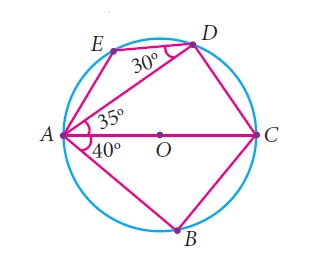
Solution :
In triangle ADC,
<ADC = 90 (angle in a semicircle)
<ADC + <DAC + <ACD = 180
90 + 35 + <ACD = 180
<ACD = 180 - 125
<ACD = 55
In triangle ACB,
<ACB + <ABC + <BAC = 180
<ACB + 90 + 40 = 180
<ACB = 180 - 130
<ACB = 50
(iii) <EDA + <ADC + <EAD + <DAC = 180
(Sum of opposite angles in a quadrilateral)
30 + 90 + <EAD + 35 = 180
<EDA = 180 - 155
<EDA = 25
Question 3 :
Find all the angles of the given cyclic quadrilateral ABCD in the figure.

Solution :
<A + <C = 180
2y + 4 + 4y - 4 = 180
6y = 180
y = 180/6
y = 30
<B + <D = 180
6x - 4 + 7x + 2 = 180
13x - 2 = 180
13x = 182
x = 182/13
x = 14
<A = 2y + 4 = 2(30) + 4 = 60 + 4 = 64
<B = 6x - 4 = 6(14) - 4 = 84 - 4 = 80
<C = 4y - 4 = 4(30) - 4 = 120 - 4 = 116
<D = 7x + 2 = 7(14) + 2 = 100
Question 4 :
In the given figure, ABCD is a cyclic quadrilateral where diagonals intersect at P such that <DBC = 40° and <BAC = 60° find
(i) <CAD (ii) BCD
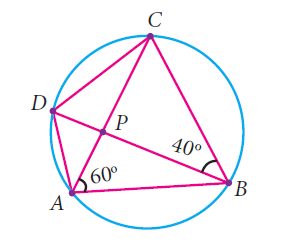
Solution :
Angles in a same segment will be equal.
<DAC = <DBC = 40
In ΔBCD, we have:
∠BCD + ∠DBC + ∠BDC = 180°
(Angle sum property of a triangle)
<BCD + 60° + 40° = 180°
∠BCD = (180° - 100°) = 80°
Question 5 :
Find the value of x if ABCD is a cyclic quadrilateral if ∠1 : ∠2 = 3 : 6.
a) 90° b) 45° c) 60° d) 20°

Solution :
In cyclic quadrilateral, the sum of opposite angles is equal to 180 degree.
The ratio between ∠1 and ∠2 is = 3 : 6
Let ∠1 = 3a and ∠2 = 6a
∠1 + ∠2 = 3a + 6a
9a = 180
a = 180/9
a = 20
By observing the figure above,
∠2 + x = 180
∠2 = 6(20) ==> 120
120 + x = 180
x = 180 - 120
x = 60
Question 6 :
ABCD is a cyclic parallelogram. Show that it is a rectangle.
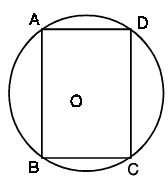
Solution :
In any cyclic quadrilateral, sum of opposite angles is equal to 180 degree.
∠B + ∠D = 180
In a parallelogram, the opposite angles are equal.
∠B = ∠D
∠B + ∠B = 180
2∠B = 180
∠B = 90 degree
So, the ABCD is a rectangle.
Question 7 :
If PQRS is a cyclic quadrilateral and PQ is diameter, find the value of ∠PQS.
a) 45° b) 110° c) 20° d) 80°
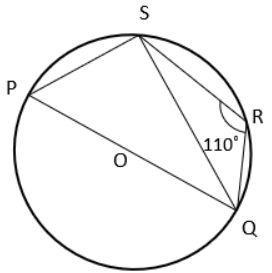
Solution :
∠SRQ + ∠SPQ = 180
110 + ∠SPQ = 180
∠SPQ = 180 - 110
∠SPQ = 70
∠PSQ = 90 (angle in a semicircle)
In triangle PSQ,
∠PSQ + ∠SPQ + ∠PQS = 180
90 + 70 + ∠PQS = 180
160 + ∠PQS = 180
∠PQS = 180 - 160
∠PQS = 20
Question 8 :
Find the value of x and y if ABCD is cyclic quadrilateral.

a) 60°, 60° b) 50°, 60° c) 45°, 45° d) 80°, 90
Solution :
∠A + ∠C = 180
x + 2y = 180 -------(1)
∠B + ∠D = 180
x + y + 2x - y = 180
3x = 180
x = 180 / 3
x = 60
Applying the value of x, we get
60 + 2y = 180
2y = 180 - 60
2y = 120
y = 120 / 2
y = 60
So, option a is correct.
Question 9 :
What is the value of ∠PQR if PQRS is cyclic quadrilateral and PS = SR?
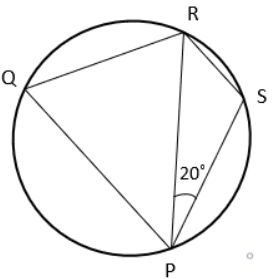
a) 90° b) 70° c) 40° d) 30°
Solution :
In a triangle PSR,
∠PSR + ∠SPR + ∠SRP = 180
∠PSR + 20 + 20 = 180
∠PSR + 40 = 180
∠PSR = 180 - 40
∠PSR = 140
∠RQP + ∠PSR = 180
∠RQP + 140 = 180
∠RQP = 180 - 140
∠RQP = 40
So, option c is correct.
Question 10 :
What is the value of ∠PRQ if ∠PSR : ∠PQR = 1 : 2?

a) 50° b) 10° c) 90° d) 45°
Solution :
Given that, ∠PSR : ∠PQR = 1 : 2
∠PSR = x and ∠PQR = 2x
x + 2x = 180
3x = 180
x = 180/3
x = 60
In triangle PRQ,
∠PQR + ∠QRP + ∠RPQ = 180
∠PQR = 2x
= 2(60)
∠PQR = 120
120 + ∠QRP + 50 = 180
170 + ∠QRP = 180
∠QRP = 180 - 170
∠QRP = 10
Kindly mail your feedback to v4formath@gmail.com
We always appreciate your feedback.
©All rights reserved. onlinemath4all.com
Recent Articles
-
Digital SAT Math Problems and Solutions (Part - 150)
Apr 25, 25 11:46 AM
Digital SAT Math Problems and Solutions (Part - 150) -
AP Calculus AB Problems with Solutions (Part - 19)
Apr 24, 25 11:10 PM
AP Calculus AB Problems with Solutions (Part - 19) -
AP Calculus AB Problems with Solutions (Part - 18)
Apr 24, 25 11:06 PM
AP Calculus AB Problems with Solutions (Part - 18)
